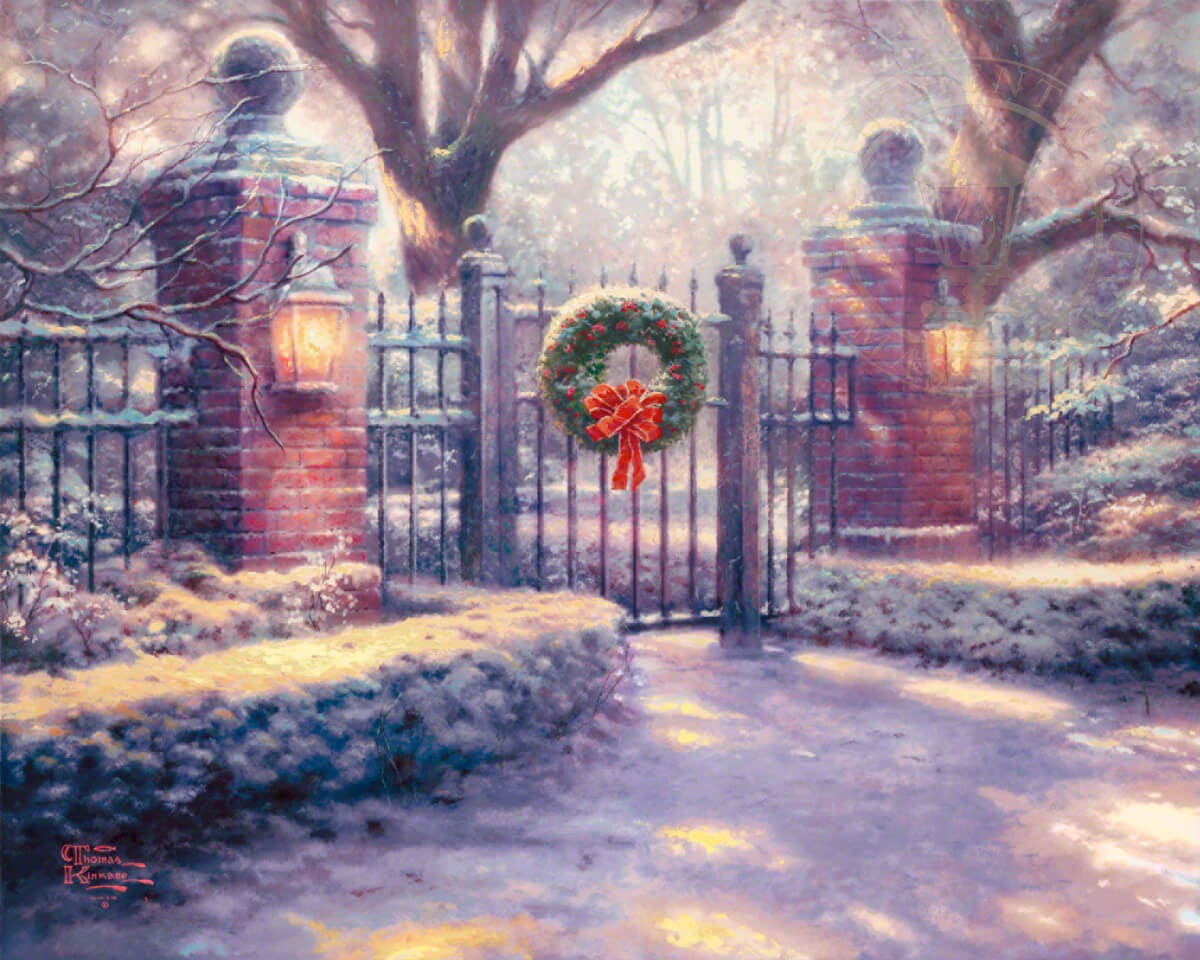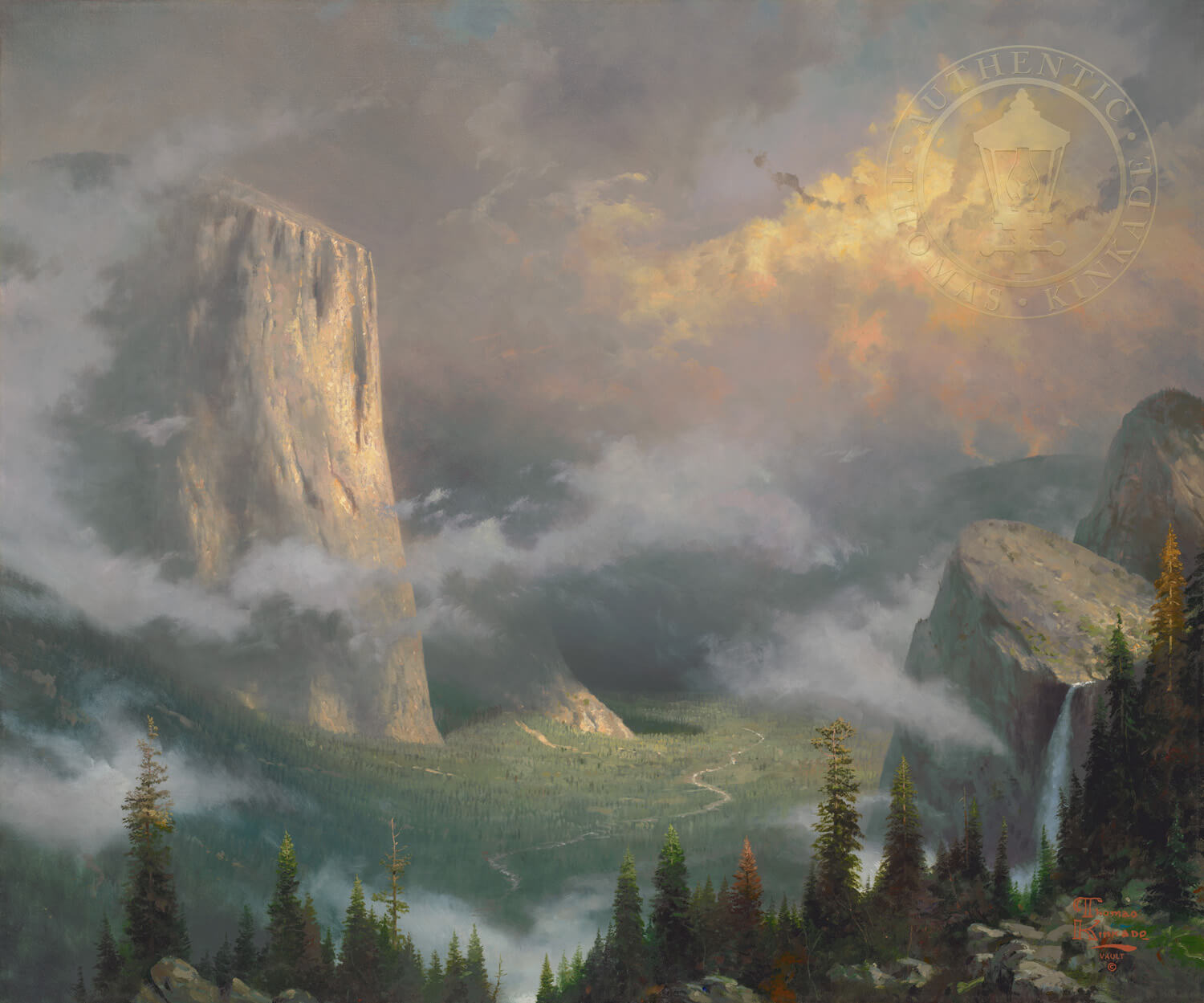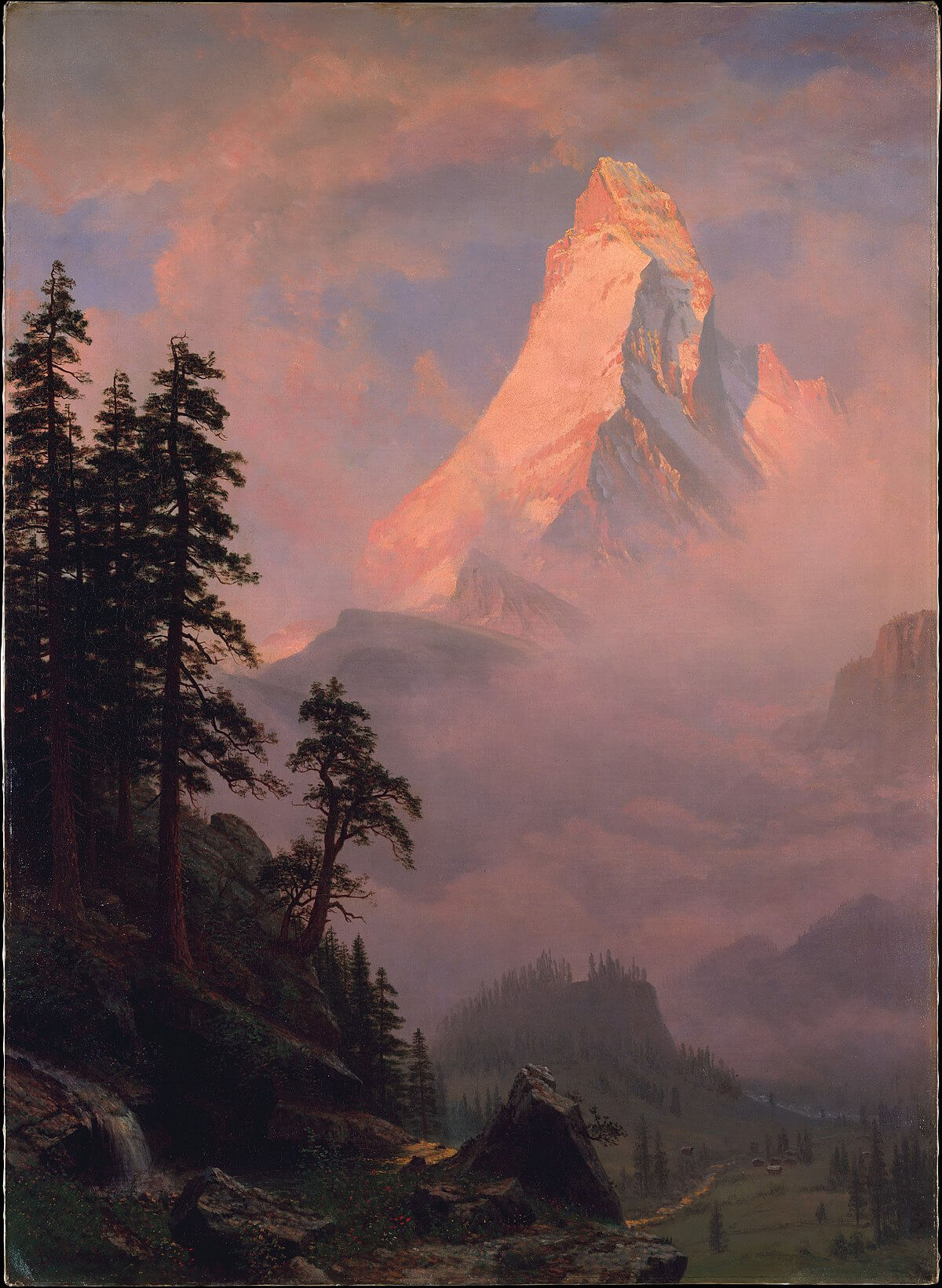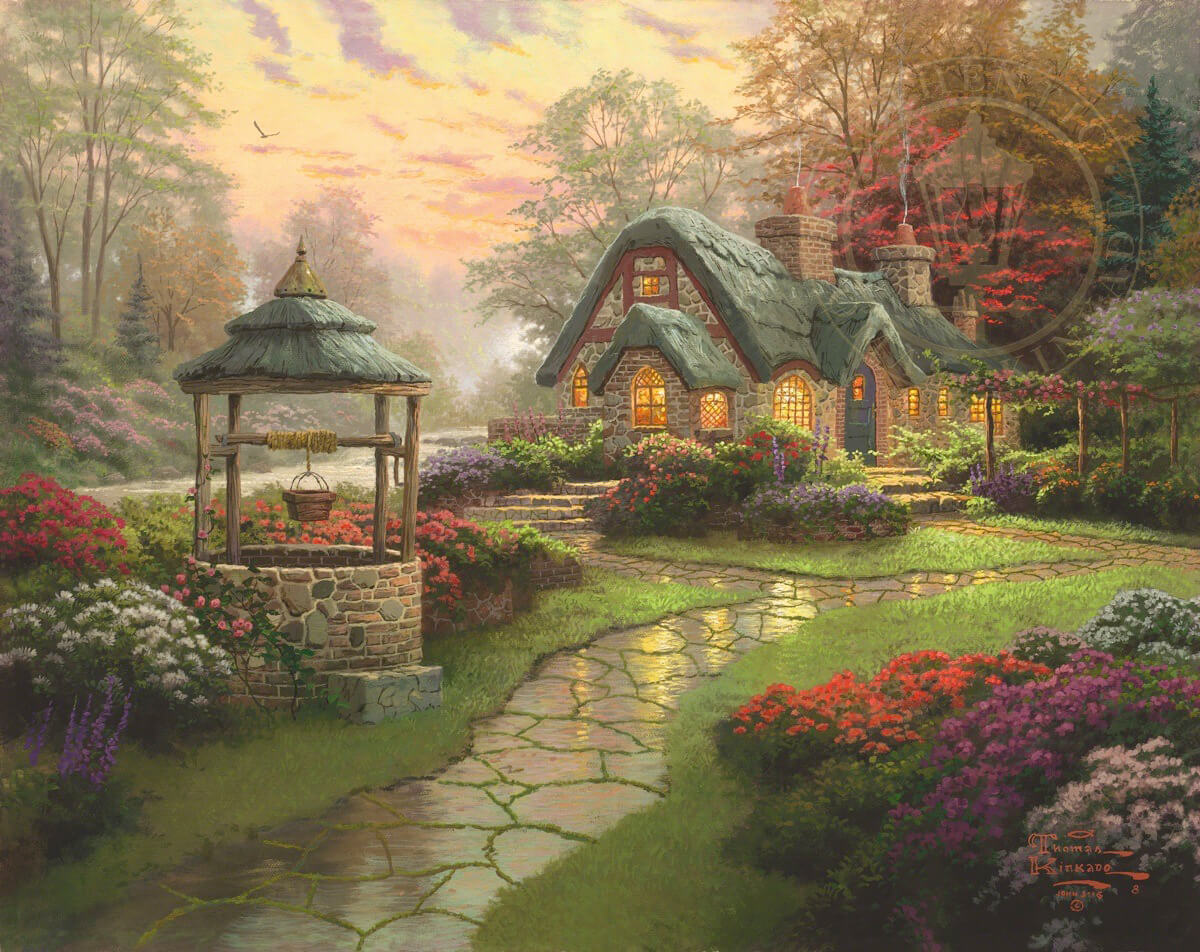A Dream From Christmas Cottage
Alissa Bennett
December 31, 2019

It was just four years before he accidentally dispatched himself from planet Earth with a suicidally reckless cocktail of Valium and vodka that Thomas Kinkade celebrated the release of his Hallmark Channel-esque biopic, Thomas Kinkade’s Christmas Cottage. The film has the empty-calorie appeal specific to Kinkade’s most beloved paintings. It is a nostalgia bacchanal that fetishizes the American myth that a hard-scrabble childhood can be transformed into a multimillion-dollar enterprise with a little bit of hard work and a hefty passion for Jesus Christ.
I won’t lie and claim that I sat through all 90 minutes of this masterpiece—the beauty of it is that you need not invest too heavily to understand precisely where the narrative will lead—but I watched enough to understand that its revisionism of the artist’s life is structurally analogous to his oeuvre.
Christmas Cottage’s wholesome veneer masks a squalid truth: it is a glimmering snow globe in which we can contemplate the relationship between poverty and desire without ever having to venture somewhere truly ugly. Gone from this account are the blocks of government cheese that sat on Kinkade’s childhood kitchen counter, gone are his own ham sandwich looks (he is played by Jared Padalecki, heartthrob of the small screen). Gone is his enthusiasm for prescription drugs and alcohol. Here you’ll find neither extramarital lust nor fits of rage, only a twinkling golden glow that issues forth from a Christmas Cottage, a tidy home where the eggnog is rated G and there are gifts enough for all.
The aesthetic hallmarks of Thomas Kinkade’s paintings are so interwoven in the polyester fiber of late 20th-century America that it’s unnecessary to describe their formal qualities in any detail. The pixie-dust shimmer of his burgs and hollows is synonymous with his name, and though his glinting lawns are perpetually vacant, we know without looking through his church windows that the pews inside are full. On their industrially manufactured surfaces, Kinkade’s paintings speak to the most homogenous desires of the American heart, which makes it easy to dismiss them as a particularly cynical lesson in kitsch. All reasonable people understand that church is boring and that only maniacs fantasize about living in Cinderella’s castle, and maybe that’s precisely the point. Kinkade’s work reminds us that our desires are stupid and escapist, that our ideals are absurd, and that you only throw a penny in a wishing well if your life already sucks badly enough to seek relief in an act of delusion.
Kinkade himself was no stranger to the perils of getting what you wish for. By the mid-1980s, the self-proclaimed born-again Christian was generating so much revenue from prints of his work that he stopped selling the originals altogether. Instead, he stored them in a warehouse until they could be transferred to the museum he imagined one day establishing in his own honor. The reproductions, which were printed on canvas and daubed strategically with oil paint by specially trained elves, were sold in franchise shops that moved enough merchandise to render Kinkade not only incredibly wealthy, but also one of the most collected artists in American history. At the height of his career, it was estimated that a Kinkade hung in one out of twenty American homes.

The commercial success of Kinkade’s thrift-store sentimentality aligns neatly with Clement Greenberg’s famous derision of mass-produced art and the people who love it. In his seminal 1939 essay, “Avant-Garde and Kitsch,” Greenberg argued that industrialization and urbanization made people too apathetic to engage with art in ways that were intellectually or politically rigorous, so they just framed up some shitty Currier and Ives prints and called it a day.
Though Pop Art’s recontextualization of mass-produced imagery certainly altered the language with which we address the aesthetics of ubiquity, Kinkade’s paintings have—since his earliest notoriety— been critically dismissed as cheap repositories of synthetic familiarity. Kinkade must have felt a measure of grandiosity that his success was found in spite (and perhaps because) of the art world’s disdain for him. Having once famously proclaimed “God is my art agent,” the painter made it clear that he didn’t need the approval of the culture industry—he had the approval of millions of depressed people everywhere.
This tension between public approbation and critical repudiation finds an apt counterpart in the career of German-American painter Albert Bierstadt, whose luminous depictions of the American frontier certainly situate him as Kinkade’s vernacular forbearer. But Bierstadt was also derided as a huckster, a businessman who exploited the romantic notions proffered by Manifest Destiny and transformed them into capital. In spite of the public’s affection for his elysian landscapes (and the aspirations they paid service to), Bierstadt’s work was widely viewed by critics as manipulative opportunism, as intellectually antiseptic flattery designed to separate men from their money.
Though interest had dissipated by the end of his life and Bierstadt died bankrupt and in virtual obscurity, time has given his work the benefit of reconsideration. We are now several generations removed from the world in which these paintings were made, and they no longer suggest tacky technicolor showboating; they seem instead like portraits of a country that has become a stranger to us. One could argue that this reinvigorated attraction is just another kind of nostalgia, an expression of our lust for loss. It feels good to believe we are remembering how we once were; just ask Thomas Kinkade.
I need not explain why there was no postmortem art-market clamor for Kinkade, nor why there has never been a recuperative gesture that aims to re-situate the work outside of the mall. Though Kinkade’s paintings often pander to Evangelical Christianity (which is probably the most legitimate reason to hate them), the primary reason that the art world has erected aesthetic and conceptual barricades around him is one that echoes Greenberg’s 80-year-old essay: we think it’s stupid art for stupid people. That is, those who are too intellectually flabby to spot the difference between The Real and a charlatan’s flattened approximation of it.
As Francesco Bonami writes, Kinkade’s work “indulges in the mundane to ideologically exploit the banal.” For Bonami, The Christmas Village is nothing more than a dollar store theatrical set devoid of content and designed to dazzle, a tautological feedback loop that offers impoverished ideas to impoverished minds. Critics suggest that peeking into one of Kinkade’s houses would reveal nothing inside but a money printing machine and a pile of dust, but I believe that we would also find a partially deflated air mattress, an empty fifth of gin, and a heavily notated Bible. Opened to Revelations.

Kinkade often reflected on his impoverished childhood; he often thanked God for teleporting a paintbrush into his hand and for bringing him his wife Nanette and their daughters; he expressed gratitude that his art touched so many and that he had been able to parlay it into a life he only could have dreamed about as a boy. This was, of course, the Painter of Light ™ version of reality. Expunged from it were his drug and alcohol problems and his often shaky relationship with his best friend, Jesus Christ.
The stories of Kinkade’s bad behavior thrill precisely because they bely the fibs that his paintings try to make us believe—Thomas Kinkade wanted to pee on Winnie the Pooh statuettes (yes, he did it); he wanted to scream insults at Siegfried and Roy (yes, he did it); he wanted to drink a gallon of vodka and drive through a seaside village that eerily resembled his paintings (he did that too). Behind Kinkade’s crowd-pleasing pledges to God and family was a white-knuckling alcoholic who couldn’t keep himself out of the strip club. The truth was that Thomas Kinkade had gotten everything he’d ever wanted, and it didn’t make a difference.
It’s difficult to reconcile Kinkade’s images of perfected domesticity with tales of his own well-documented depression. He once said that he painted “the places we would like to be forever,” which feels to me like Christian shorthand for death. When I look at these works, I am struck by the artist’s tacit promise that one day we won’t have to wake up crabby because one day, we won’t wake up at all. Kinkade’s incredible popularity reveals more about us than it does him, and though it’s easy to dismiss the phenomenon of his career as a symbol of America’s passion for Disney-brand escapism, it is also one that speaks to the American death drive. The fantasies proffered by Kinkade’s paintings acknowledge that real life seldom ends up being what we wish for, because the package is often better than what’s inside.
Joan Didion once wrote that Kinkade’s windows seemed to her not to depict tidy cottages with hearths aglow, but rather infernos, witches’ houses with ovens blazing in anticipation of the greedy children foolish enough to lick gumdrop doorknobs or break off sheets of peanut brittle siding. The fetishization of sentimentality, this reading suggests, is a threadbare scrim that barely distances us from the manifold brutalities of real life—nostalgia is a glamour, a spell that tricks us into thinking that we would be better off with the things that we imagine we once had.

In 2010, Kinkade’s company filed for Chapter 11 bankruptcy in order to protect his assets from creditors and gallery franchise owners who were collectively seeking $6.2 million in damages. The year ushered in a slew of PR fiascos, including the dissolution of his marriage and a DWI charge that led to 10 days in jail. It was later claimed that the suspension of his license led Kinkade to hire a driver who escorted him around town while he slammed $200 bottles of Silver Oak cabernet out of a water bottle. Reports began to surface about catastrophic personal appearances and temper tantrums; allegations of sexual misconduct and rumors of relapse slowly found their way to newspapers and gossip columns. After one particularly disastrous event in Denver, the artist finally provided a statement. “I sneeze in public,” he said, “and I make a headline.”
The grubby biographical details that began to spill out about Kinkade’s bad behavior likely did little to dissuade believers. His life sucked too, they realized, and isn’t that precisely what his work was about in the first place? A cursory review of the official Thomas Kinkade website reveals a Christmas painting that was released in tandem with the first public indications that his life had begun to unravel. The image, titled Christmas Gate, features two lamp-lit pillars straddling a wreath-festooned iron gate. “I trust that this gate will speak to you as profoundly as it does to me,” the copy reads. “Behind this strong gate is a home where memories are in the making and where love abounds.” This description might be precisely what we are looking at. It just isn’t the home where Thomas Kinkade lived.
The 2012 vanity documentary An American Artist: The Life Story of Thomas Kinkade opens with a sweeping montage that celebrates Kinkade’s enormous popularity. He embraces indigenous children and chats amicably with a big-banged Kathie Lee Gifford; he shakes hands with Donald Trump, with the Clintons, with babies and the elderly; he receives the benediction from a chair-bound Pope John Paul II while his greatest hits flash across the screen. Each of the film’s 56 minutes serves a singular purpose: to remind us that Kinkade was, and remains America’s Artist, the one and only Painter of Light™.
What the documentary strategically avoids is the chaotic end of the artist’s life. We do not see the moment he left poor Nanette for a middle-aged vixen named Amy Pinto. We do not see the raging meltdowns where he berated his staff or stomped his feet. Absent is the drunkenly prepared will scrawled on a sheet of note paper in which he left all of his worldly belongings to a woman he barely knew. Never mentioned are the gold-painted toenails that were noted when his body was discovered prone on his bed. But just because this isn’t shown doesn’t mean it’s not there. All I’m saying is that maybe all of these dramas are playing out behind Kinkade’s cottage doors, that maybe we could see them if only we could get close enough to look.